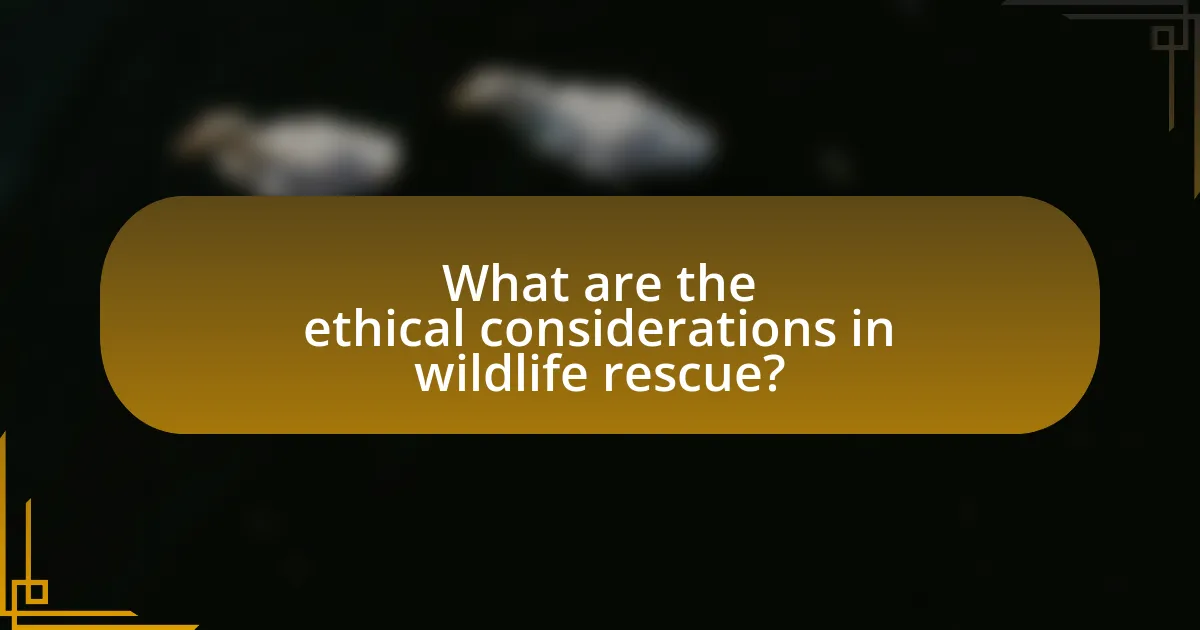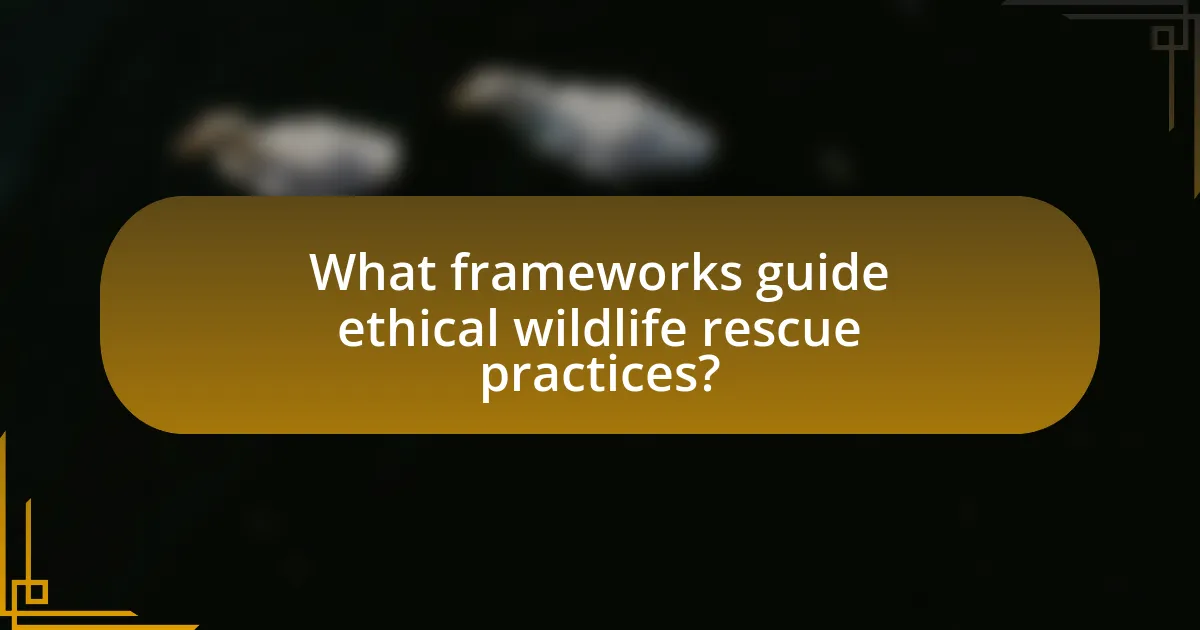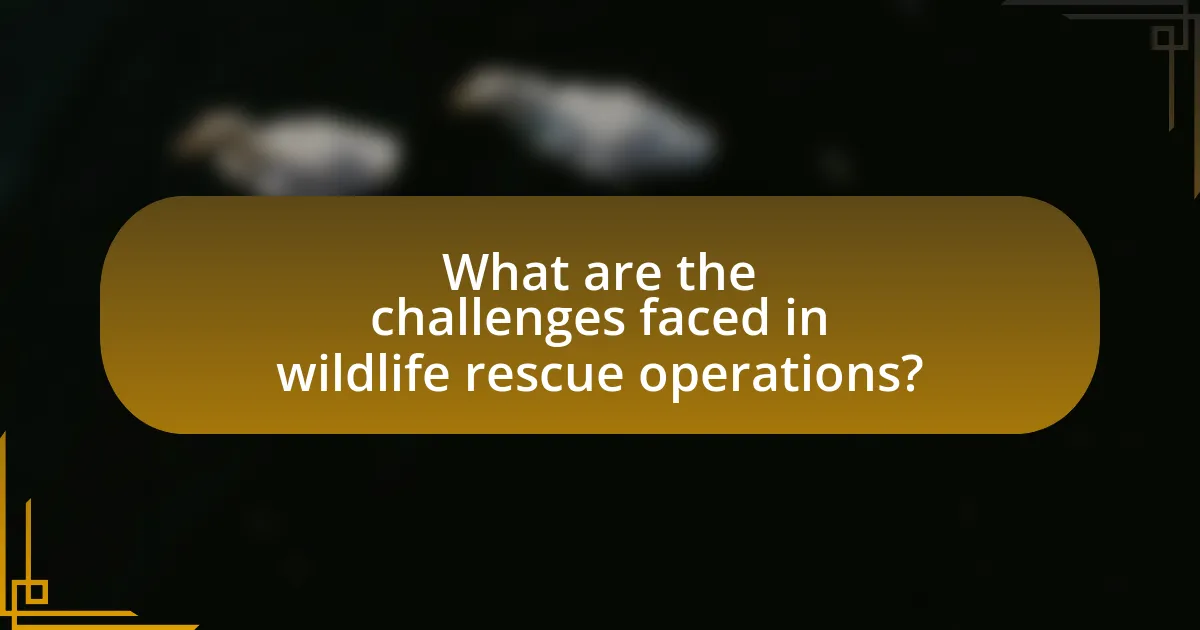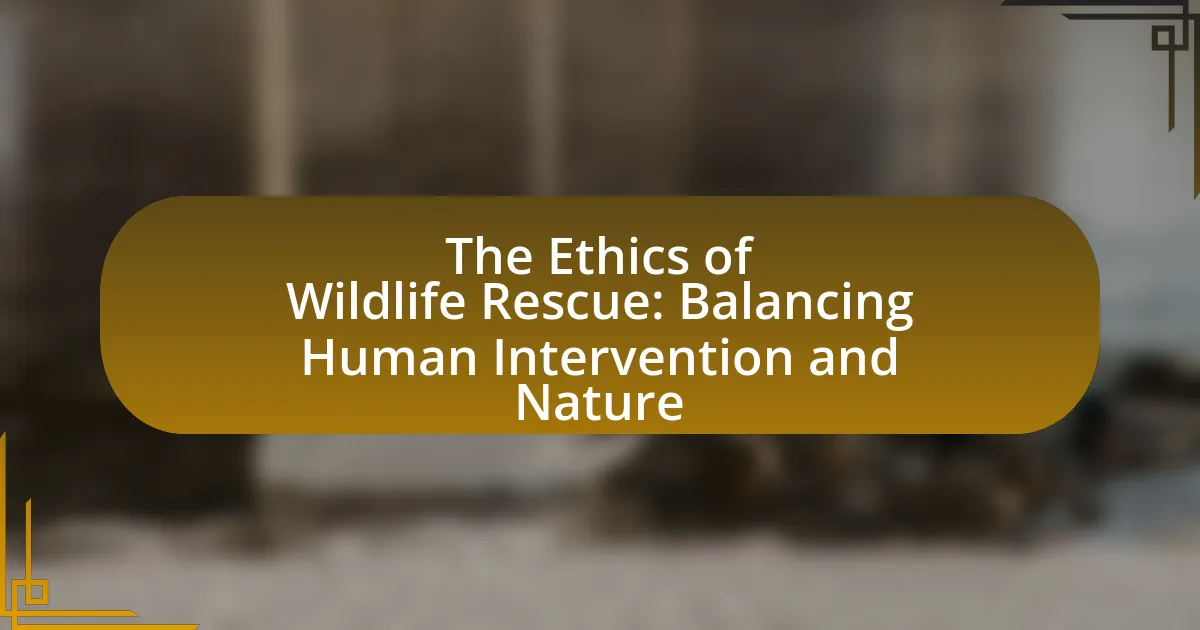The article examines the ethical considerations surrounding wildlife rescue, emphasizing the need to balance human intervention with the welfare of individual animals and the integrity of ecosystems. It discusses the importance of wildlife rescue for conservation efforts, highlighting its role in maintaining biodiversity and aiding endangered species recovery. The article also addresses the potential consequences of human intervention, including dependency on human care and disruptions to natural ecosystems. Additionally, it explores the influence of cultural perspectives on wildlife rescue ethics, the challenges faced in rescue operations, and the frameworks guiding ethical practices in wildlife rehabilitation.

What are the ethical considerations in wildlife rescue?
Ethical considerations in wildlife rescue include the welfare of the animal, the impact on ecosystems, and the potential for human interference to cause more harm than good. Wildlife rescuers must prioritize the well-being of the individual animal, ensuring that interventions do not lead to undue stress or suffering. Additionally, rescuers must consider how their actions affect the broader ecosystem, as removing an animal from its natural habitat can disrupt local populations and food chains. Research indicates that well-intentioned human intervention can sometimes result in negative outcomes, such as dependency on human care or altered behaviors that hinder survival upon release. Therefore, ethical wildlife rescue requires a careful assessment of each situation to balance the needs of individual animals with the health of the ecosystem.
Why is wildlife rescue important for conservation efforts?
Wildlife rescue is crucial for conservation efforts because it directly aids in the recovery of endangered species and the restoration of ecosystems. By rehabilitating injured or orphaned animals, wildlife rescue organizations help maintain biodiversity, which is essential for ecosystem stability and resilience. For instance, the International Union for Conservation of Nature (IUCN) reports that wildlife rescue initiatives have successfully contributed to the recovery of species such as the California condor, which was brought back from the brink of extinction through targeted rescue and breeding programs. This demonstrates that wildlife rescue not only saves individual animals but also plays a vital role in broader conservation strategies aimed at preserving natural habitats and species diversity.
How does wildlife rescue contribute to biodiversity preservation?
Wildlife rescue contributes to biodiversity preservation by rehabilitating injured or orphaned animals, which helps maintain healthy populations of various species. By providing care and support, wildlife rescue organizations prevent the decline of species that may be threatened or endangered, thereby supporting ecosystem balance. For instance, the International Union for Conservation of Nature (IUCN) reports that rehabilitated animals can be reintroduced into their natural habitats, which aids in sustaining genetic diversity and ecological resilience. This intervention is crucial as it mitigates the impacts of habitat loss, poaching, and climate change on wildlife populations, ultimately fostering a more diverse and stable ecosystem.
What role does public awareness play in wildlife rescue initiatives?
Public awareness is crucial in wildlife rescue initiatives as it fosters community engagement and support for conservation efforts. Increased awareness leads to higher participation in rescue programs, volunteer opportunities, and donations, which are essential for funding and resources. For instance, studies have shown that public campaigns can significantly increase the number of reported wildlife emergencies, enabling quicker responses and better outcomes for affected animals. Furthermore, informed communities are more likely to adopt practices that protect wildlife habitats, thereby reducing the need for rescue interventions in the first place.
What are the potential consequences of human intervention in wildlife rescue?
Human intervention in wildlife rescue can lead to both positive and negative consequences. On the positive side, intervention can save individual animals from immediate threats, such as injury or habitat destruction, thereby contributing to species conservation efforts. For instance, rehabilitation programs have successfully increased the populations of endangered species like the California condor, which was brought back from the brink of extinction through human-led rescue initiatives.
Conversely, negative consequences may arise, such as dependency on human support, which can disrupt natural behaviors and ecosystems. Animals that are frequently rescued may lose their ability to survive independently, leading to a cycle of reliance on human intervention. Additionally, human involvement can inadvertently introduce diseases or alter genetic diversity within populations, as seen in cases where captive breeding programs have led to inbreeding issues.
Overall, while human intervention can provide critical support for wildlife, it is essential to consider the long-term ecological impacts and strive for a balance that prioritizes both animal welfare and ecosystem integrity.
How can human intervention disrupt natural ecosystems?
Human intervention can disrupt natural ecosystems by altering habitats, introducing invasive species, and changing species interactions. For instance, urban development leads to habitat loss, which can result in decreased biodiversity and the extinction of local species. Additionally, the introduction of non-native species, such as the Burmese python in Florida, can outcompete native wildlife, leading to significant ecological imbalances. Furthermore, human activities like pollution and climate change can affect the health of ecosystems, causing shifts in species distribution and altering food webs. These disruptions highlight the complex consequences of human actions on ecological integrity.
What are the risks of dependency on human assistance for wildlife?
Dependency on human assistance for wildlife poses significant risks, including the disruption of natural behaviors and ecosystems. When wildlife becomes reliant on humans for food, shelter, or care, it can lose essential survival skills, such as foraging and predator avoidance. This dependency can lead to population declines when human support is withdrawn, as seen in cases where rehabilitated animals struggle to survive in the wild due to a lack of learned skills. Additionally, human intervention can alter natural selection processes, favoring individuals that thrive in human-altered environments rather than those best adapted to their natural habitats. This shift can result in decreased genetic diversity and resilience within wildlife populations, ultimately threatening their long-term survival.
How do cultural perspectives influence wildlife rescue ethics?
Cultural perspectives significantly influence wildlife rescue ethics by shaping beliefs about the intrinsic value of animals and the role of humans in nature. Different cultures prioritize various ethical frameworks, such as utilitarianism, which focuses on the greatest good for the greatest number, or biocentrism, which emphasizes the inherent rights of all living beings. For instance, Indigenous cultures often view wildlife as interconnected with their identity and heritage, leading to a more holistic approach to rescue efforts that respects ecological balance. In contrast, Western perspectives may prioritize species conservation based on economic or aesthetic values, which can lead to differing rescue strategies. Research indicates that these cultural values directly impact policy-making and community engagement in wildlife rescue initiatives, as seen in studies like “Cultural Influences on Wildlife Conservation” by Smith et al., published in the Journal of Environmental Management, which highlights how local beliefs shape conservation practices.
What are the differing views on wildlife intervention across cultures?
Differing views on wildlife intervention across cultures reflect a spectrum of beliefs shaped by historical, environmental, and ethical considerations. For instance, Indigenous cultures often emphasize a harmonious relationship with nature, advocating for minimal intervention to preserve ecological balance, as seen in many Native American practices that prioritize coexistence with wildlife. In contrast, Western cultures may support more active intervention strategies, such as wildlife rehabilitation and management, driven by conservation goals and the belief in human responsibility to protect endangered species. This is evident in policies like the Endangered Species Act in the United States, which promotes human-led efforts to restore populations. Additionally, some cultures view wildlife as resources for economic development, leading to interventions that prioritize hunting or tourism, which can conflict with conservation efforts. These varying perspectives highlight the complexity of wildlife intervention ethics across different cultural contexts.
How do local traditions impact wildlife rescue practices?
Local traditions significantly influence wildlife rescue practices by shaping community attitudes and methods toward animal care and conservation. For instance, in some cultures, certain species are revered and protected due to spiritual beliefs, leading to community-led rescue initiatives that prioritize the welfare of these animals. Conversely, in areas where wildlife is viewed as a resource, local traditions may promote practices that harm animals, such as hunting or habitat destruction, which can hinder rescue efforts. Research indicates that integrating local knowledge and customs into wildlife management strategies enhances the effectiveness of rescue operations, as seen in the case of indigenous practices in Australia that have successfully contributed to the conservation of endangered species.

What frameworks guide ethical wildlife rescue practices?
Ethical wildlife rescue practices are guided by frameworks such as the International Wildlife Rehabilitation Council (IWRC) guidelines, the National Wildlife Rehabilitators Association (NWRA) standards, and the principles of the One Health approach. The IWRC emphasizes the importance of minimizing human impact on wildlife and promoting the welfare of individual animals, while the NWRA provides a code of ethics that includes considerations for animal care, public education, and habitat preservation. The One Health approach integrates human, animal, and environmental health, advocating for a holistic perspective in wildlife rescue efforts. These frameworks collectively ensure that wildlife rescue operations prioritize animal welfare, ecological balance, and community engagement.
What guidelines exist for ethical wildlife rehabilitation?
Ethical wildlife rehabilitation guidelines emphasize the importance of minimizing human intervention while ensuring the welfare of injured or orphaned animals. These guidelines include assessing the animal’s condition and determining if rehabilitation is necessary, providing appropriate care that mimics natural conditions, and ensuring that the ultimate goal is to release the animal back into its natural habitat. Additionally, rehabilitation efforts must comply with local wildlife laws and regulations, and practitioners should possess the necessary training and permits to handle wildlife. These principles are supported by organizations such as the National Wildlife Rehabilitators Association, which outlines best practices for rehabilitation to promote animal welfare and conservation.
How do these guidelines ensure the welfare of rescued animals?
These guidelines ensure the welfare of rescued animals by establishing standards for their care, rehabilitation, and release. Specifically, they outline best practices for nutrition, medical treatment, and habitat management, which are crucial for the physical and psychological well-being of the animals. For instance, guidelines often recommend species-specific diets and veterinary care protocols that have been shown to improve recovery rates in wildlife rehabilitation. Additionally, they emphasize the importance of minimizing human interaction to reduce stress and promote natural behaviors, thereby enhancing the animals’ chances of successful reintegration into their natural habitats.
What are the best practices for assessing animal health before rescue?
The best practices for assessing animal health before rescue include conducting a visual examination, evaluating behavior, and checking for signs of injury or illness. A visual examination allows rescuers to identify any obvious physical issues, such as wounds or malnutrition. Evaluating behavior helps determine if the animal is in distress or capable of self-sustenance, which is crucial for deciding whether intervention is necessary. Checking for signs of injury or illness, such as limping or labored breathing, provides insight into the animal’s overall health status. These practices are supported by guidelines from wildlife rehabilitation organizations, which emphasize the importance of thorough assessments to ensure that only animals in genuine need of help are rescued, thereby minimizing unnecessary human intervention.
How do organizations balance intervention with natural processes?
Organizations balance intervention with natural processes by implementing evidence-based strategies that prioritize ecological integrity while addressing immediate wildlife needs. For instance, wildlife rescue organizations often assess the health and viability of animal populations before intervening, ensuring that their actions do not disrupt natural selection or ecosystem dynamics. Research indicates that interventions, such as rehabilitation and relocation, are conducted only when there is a clear benefit to the species and minimal impact on the ecosystem, as seen in studies by the International Union for Conservation of Nature. This approach helps maintain biodiversity and supports the resilience of natural habitats while fulfilling ethical responsibilities to injured or endangered wildlife.
What strategies are used to minimize human impact during rescue?
Strategies used to minimize human impact during rescue include employing low-impact techniques, utilizing trained professionals, and prioritizing habitat preservation. Low-impact techniques, such as using specialized equipment that reduces disturbance to wildlife and their habitats, help ensure that the natural environment remains intact. Trained professionals, including wildlife rehabilitators and ecologists, apply their expertise to assess the situation and implement rescue operations that are sensitive to the ecological balance. Additionally, prioritizing habitat preservation during rescue efforts ensures that the natural ecosystem is not adversely affected, which is crucial for the long-term survival of the species involved. These strategies are supported by guidelines from organizations like the International Wildlife Rehabilitation Council, which emphasizes the importance of minimizing stress and disruption to wildlife during rescue operations.
How can wildlife rescue efforts be integrated with habitat conservation?
Wildlife rescue efforts can be integrated with habitat conservation by implementing strategies that prioritize both the rehabilitation of individual animals and the preservation of their natural environments. For instance, organizations can develop rescue programs that focus on species endemic to specific habitats, ensuring that efforts to save animals also include initiatives to protect and restore those habitats. Research indicates that habitat loss is a primary driver of wildlife decline, with approximately 1 million species at risk of extinction due to habitat destruction (IPBES, 2019). By aligning rescue operations with habitat conservation goals, such as reforestation or wetland restoration, wildlife organizations can create a synergistic approach that enhances ecosystem health while addressing immediate animal welfare needs. This integrated strategy not only aids in the recovery of individual species but also fosters biodiversity and ecosystem resilience.
What role do laws and regulations play in wildlife rescue ethics?
Laws and regulations are fundamental in shaping wildlife rescue ethics by establishing legal frameworks that govern the treatment and protection of wildlife. These legal structures ensure that rescue operations adhere to ethical standards, promoting the welfare of animals while balancing human intervention. For instance, the Endangered Species Act in the United States mandates the protection of threatened species, guiding rescue efforts to prioritize conservation and ethical treatment. Additionally, regulations often dictate the qualifications and practices of wildlife rehabilitators, ensuring that interventions are conducted by trained professionals who adhere to ethical guidelines. This legal oversight not only protects wildlife but also fosters public trust in wildlife rescue initiatives.
How do legal frameworks protect both wildlife and human interests?
Legal frameworks protect both wildlife and human interests by establishing regulations that ensure sustainable use of natural resources while safeguarding ecosystems. These frameworks, such as the Endangered Species Act in the United States, create legal protections for threatened species, which in turn helps maintain biodiversity that is crucial for human survival, including clean air and water. Additionally, laws like the Convention on International Trade in Endangered Species (CITES) regulate trade in wildlife to prevent exploitation, thereby balancing economic interests with conservation efforts. By enforcing penalties for violations, these legal structures incentivize compliance and promote coexistence between human activities and wildlife conservation.
What are the consequences of violating wildlife rescue laws?
Violating wildlife rescue laws can result in significant legal penalties, including fines, imprisonment, and the revocation of permits. For instance, in the United States, the Lacey Act imposes penalties of up to $250,000 for individuals and $500,000 for organizations found guilty of violating wildlife protection laws. Additionally, violators may face civil liabilities, including restitution for damages caused to wildlife populations and ecosystems. These laws are enforced to protect endangered species and maintain biodiversity, underscoring the importance of compliance in wildlife conservation efforts.

What are the challenges faced in wildlife rescue operations?
Wildlife rescue operations face numerous challenges, including limited resources, legal restrictions, and the unpredictability of animal behavior. Limited funding and manpower often hinder the ability to provide adequate care and rehabilitation for rescued animals, as many organizations rely on donations and grants. Legal restrictions can complicate rescue efforts, as regulations may dictate how and when animals can be rescued, often delaying urgent interventions. Additionally, the unpredictability of animal behavior poses risks to both the animals and the rescuers, as stressed or injured wildlife may react aggressively, complicating the rescue process. These challenges highlight the complexities involved in balancing human intervention with the needs of wildlife.
What logistical issues complicate wildlife rescue efforts?
Wildlife rescue efforts face several logistical issues, including transportation challenges, resource limitations, and coordination difficulties among various organizations. Transportation challenges arise from the need to reach remote or hazardous locations quickly, often requiring specialized vehicles or equipment. Resource limitations, such as insufficient funding, personnel, or medical supplies, hinder the ability to respond effectively to wildlife emergencies. Coordination difficulties occur when multiple agencies or volunteers are involved, leading to miscommunication and inefficient use of resources. These factors collectively complicate the timely and effective rescue of wildlife in distress.
How do resource limitations affect rescue operations?
Resource limitations significantly hinder rescue operations by restricting the availability of essential supplies, personnel, and equipment needed for effective intervention. For instance, a lack of funding can lead to insufficient staffing, which directly impacts the speed and efficiency of rescue efforts. According to a study published in the Journal of Wildlife Management, organizations with limited financial resources often struggle to mobilize teams quickly, resulting in delayed responses that can exacerbate the plight of affected wildlife. Additionally, inadequate access to medical supplies and transportation can prevent timely treatment and relocation of injured animals, ultimately affecting survival rates.
What are the challenges of coordinating with multiple stakeholders?
Coordinating with multiple stakeholders presents challenges such as conflicting interests, communication barriers, and differing priorities. Conflicting interests arise when stakeholders have varying goals, which can lead to disagreements on the direction of wildlife rescue efforts. Communication barriers often stem from diverse backgrounds and expertise levels among stakeholders, making it difficult to share information effectively. Additionally, differing priorities can result in misalignment on resource allocation and project timelines, complicating collaborative efforts. These challenges are particularly evident in wildlife rescue scenarios, where stakeholders may include government agencies, non-profit organizations, and local communities, each with unique perspectives and objectives.
How do ethical dilemmas arise in specific rescue scenarios?
Ethical dilemmas in specific rescue scenarios arise when rescuers must choose between competing values, such as the welfare of individual animals versus the health of ecosystems. For instance, intervening to save a distressed animal may disrupt its natural habitat or the balance of the local ecosystem, leading to unintended consequences. Research indicates that wildlife rescue efforts can sometimes result in dependency on human intervention, which may undermine the species’ ability to survive independently (Bertram & Vivier, 2002, “The Ethics of Wildlife Rehabilitation,” Journal of Wildlife Management). Thus, rescuers face complex decisions that weigh immediate animal welfare against long-term ecological impacts.
What decisions must rescuers make when dealing with injured wildlife?
Rescuers must decide whether to intervene, assess the severity of the animal’s injuries, and determine the appropriate course of action for rehabilitation or euthanasia. These decisions are critical as they balance the animal’s welfare with ecological considerations. For instance, if an animal is severely injured and unlikely to survive in the wild, euthanasia may be the most humane option. Conversely, if the injuries are treatable, rescuers must evaluate the resources available for rehabilitation and the potential for successful release back into its natural habitat. The decision-making process is guided by ethical frameworks that prioritize the well-being of the animal while considering the broader implications for the ecosystem.
How can rescuers navigate conflicting interests in wildlife rescue?
Rescuers can navigate conflicting interests in wildlife rescue by prioritizing the welfare of the animals while considering ecological balance and community needs. This involves assessing the specific circumstances of each rescue situation, including the species involved, the potential impact on local ecosystems, and the perspectives of stakeholders such as local communities and conservationists. For example, a study published in the journal “Conservation Biology” highlights that effective communication and collaboration among various stakeholders can lead to more informed decision-making, ultimately benefiting both wildlife and human interests. By employing a transparent decision-making process and engaging with diverse viewpoints, rescuers can find solutions that respect both animal welfare and ecological integrity.
What are the best practices for effective wildlife rescue?
The best practices for effective wildlife rescue include assessing the situation, ensuring personal safety, and contacting trained professionals. Assessing the situation involves evaluating the animal’s condition and the environment to determine if intervention is necessary. Ensuring personal safety is crucial, as injured or distressed animals may act unpredictably. Contacting trained professionals, such as wildlife rehabilitators or local animal control, ensures that the animal receives appropriate care and that the rescue adheres to legal and ethical standards. These practices are supported by guidelines from organizations like the National Wildlife Rehabilitators Association, which emphasize the importance of proper training and knowledge in wildlife rescue efforts.
How can volunteers be trained to assist in wildlife rescue efforts?
Volunteers can be trained to assist in wildlife rescue efforts through structured programs that include hands-on training, educational workshops, and mentorship from experienced professionals. These training programs typically cover essential skills such as animal handling, first aid for wildlife, species identification, and understanding local ecosystems. For instance, organizations like the International Wildlife Rehabilitation Council provide comprehensive training resources and certification programs that equip volunteers with the necessary knowledge and skills to effectively participate in wildlife rescue operations. Additionally, practical experience gained through supervised fieldwork enhances volunteers’ confidence and competence in real-life rescue scenarios.
What resources are available for improving wildlife rescue techniques?
Resources available for improving wildlife rescue techniques include training programs, online courses, and field manuals. Organizations such as the International Wildlife Rehabilitation Council (IWRC) offer comprehensive training workshops that cover best practices in wildlife care and rehabilitation. Additionally, the National Wildlife Rehabilitators Association (NWRA) provides online courses that focus on specific rescue techniques and animal handling skills. Field manuals, such as “Wildlife Rehabilitation: A Comprehensive Approach” by the IWRC, serve as essential references for rescuers, detailing protocols and procedures for various species. These resources collectively enhance the skills and knowledge necessary for effective wildlife rescue, ensuring that rescuers are well-equipped to handle diverse situations.
